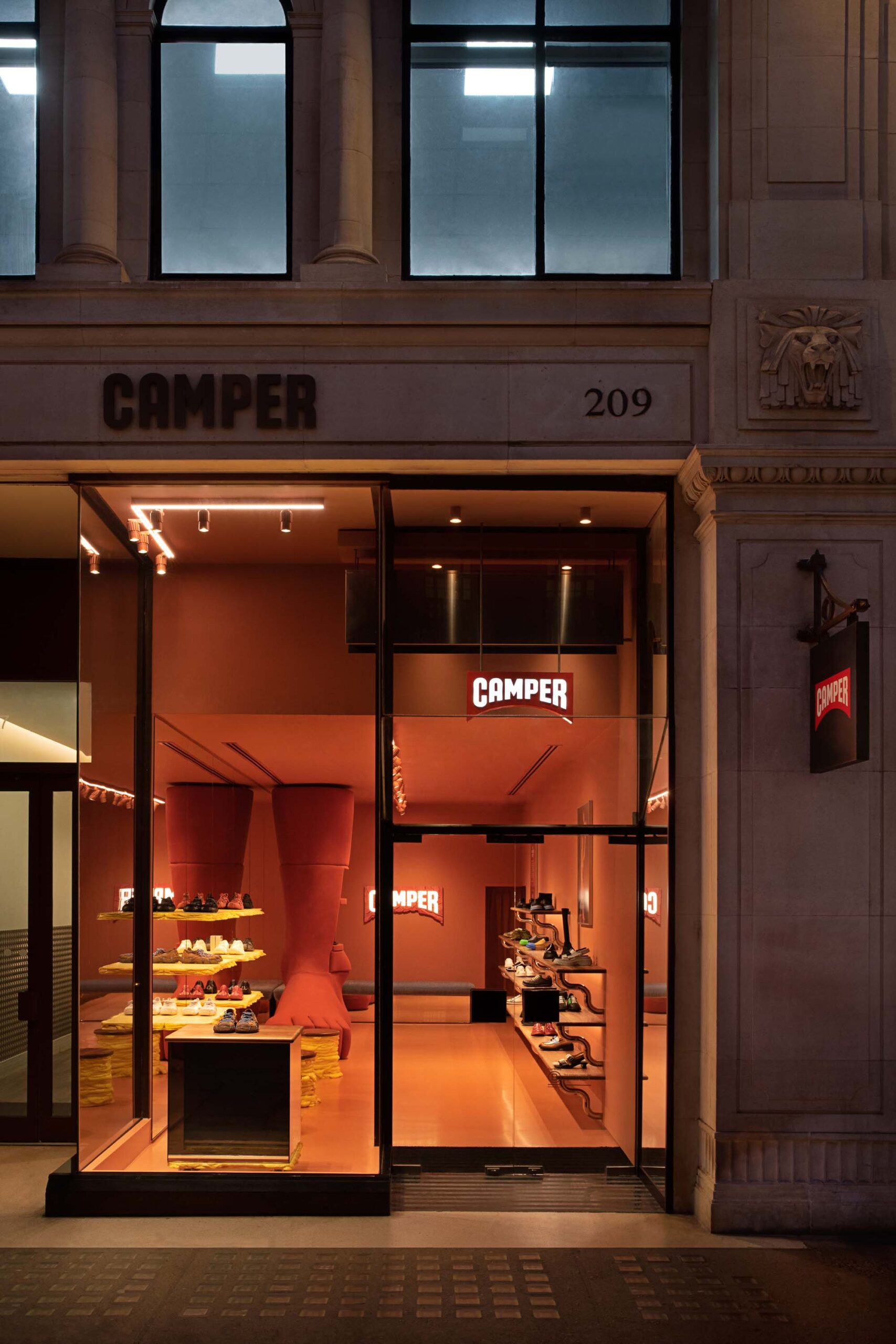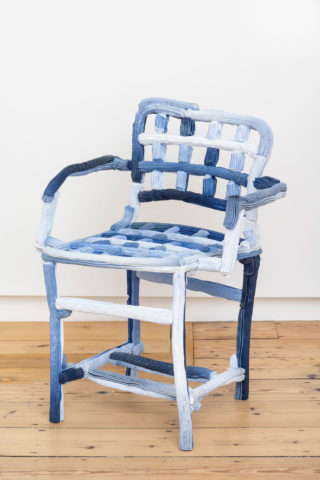Strange Friends, a vitrine of eight table top objects all of which combine different materials and forms through various techniques we have developed at the studio over the years. Referencing the growth of flowers, geological formations, scholars’ rocks and twentieth century optimism gone wrong. As I was developing the pieces I started thinking of them as ‘strange friends’ both for the combinations within each piece and the group as a whole. Shown at Hauser & Wirth Mayfair August 2023.
Interior design of the Camper store on London’s Regent Street. The space was rather long and narrow and so it made sense to make one entire wall a mirror both for customers to see themselves and to create a sense of openness and volume. A giant foot sculpture is the focal point functioning as a till, display, storage cupboard and bench for trying on shoes. Reflected in the mirrored wall the foot appears as a giant standing in the middle of the store. The whole impression is one of the surreal, unexpected and playful which in my mind connects very well with the brand values of Camper.
First presented as part of London design festival in collaboration with writer Lou Stoppard for SEEDS gallery Two Kettles No Sofa presents the apartment of an imaginary couple; Justine and Edward. Exhibition and graphic design by David McKendrick Studio.
Exhibition text below:
Designer James Shaw and writer Lou Stoppard explore themes associated with moving in together. Tastes and desires collide when two households combine to become one.
A presentation of Shaw’s design objects is mixed with historical design classics to create a fictive environment that tells the story of a couple negotiating the conflicting tastes and practicalities as they attempt to build a home together. It is a meditation on the sense of self which objects of daily use give us, and the role physical possessions, habits and compromise play in our relationships. Shaw’s objects and the arrangement of the display have been shaped by a new short story written by Stoppard – featuring a fictional couple, Justine and Edward
When any couple moves in together for the first time a clash of ideas about how we interact with the physical world emerges. Esoteric habits to do with tea-making or hand towels, which may well have been-acquired from our parents or past relationships, are suddenly forced to co-exist. Daily dramas unfold as very particular views on stacking the dishwasher unite. Battlefields emerge around taste in chairs. The home becomes a negotiation table, a physical manifestation of our ability to accept, to tolerate, and to love.
During a short residency in Marseille I began looking at ocean plastic as a raw material. Marseille is a truly cosmopolitan city, where the sea has linked people together for millennia.
Experimenting with ocean plastic was fascinating, the material behaves very differently from the recycled plastic I typically work with. It creates a rough texture and more muted colours which somehow seem of the sea. Although we washed and tried to separate the material as much as possible there were inevitably many contaminants remaining raising the question how can we make this into a virtue, can this material express a provenance an individuality due to its history? Can this be something which adds to its value and character.
The results of the residency were exhibited as part of the inaugural Plastic Art Fair in St Tropez alongside works by photographer Charles Thiefaine film maker Edouard Granero.
Bi-metal Confusion Spoons by James Shaw explore non-prescriptive ergonomics. The varying handle shapes are designed to form unique correspondence with the holding hand, whether physically or aesthetically. The shapes were sketched in a free-form way before being laser cut from sheet metal, then hand formed, riveted and polished in Shaw’s South-East London workshop. Made from stainless steel, brass and aluminium.
Wood, metal and plastic have been the holy trinity of the material landscape, the archetypal textures of ‘good taste’ and modernism. In these works James Shaw references the mid twentieth century period of design and modernism where the current malaise of our usage of material was set. Polished metal and the smooth beauty of walnut timber are combined with the grotesque gloopyness of melted plastic. Particularly apt is that the plastic used is actually reclaimed from granulated ‘kodak yellow’ film canisters discovered in an old north London factory (now belonging to Max Lamb), alluding to Kodachrome, the excitement of a world in colour as expressed in the Paul Simon song.
Waste polypropylene, walnut timber, polished aluminium, mirror
Wood Metal Plastic Lamp, for Side Gallery
Polished aluminium, hand extruded HDPE, walnut timber, light fittings.
20 Chairs made in 4 days for a special dinner held by Soft Opening Gallery and Claire de Rouen books.
Riffing on office furniture these chairs are all made with swivel bases and the same pallette of materials we find in the corporate world of foam, aluminium, rubber, faux leather and paint. Referencing greats like Gunnar Anderson who worked at the start of the synthetic age, now fifty years on their presence is all pervasive.
Photography by Paul Plews
Together with Will Yates-Johnson and the help of several friends, over three consecutive summers as part of Designers on Holiday an annual gathering of designers and other creative professionals on the Swedish island of Gotland.
The Tar Sauna appears on the limestone plateau as a floating triangle surrounded by juniper bushes. Its form derives from a study of the way heat rises in a sauna; the triangular section cuts out the unused space created by the tiered seating whilst also enabling the structure to sit lightly on the ground, resting on only three points. Taking inspiration from a technique traditional to Gotland, the exterior of the sauna is coated in a drippy gloopy finish of many layers of tar, which suits the climate as the tar is a living surface that melts season after season and re-solidifies to fill any gaps that may form. A wood burning stove heats the tongue-and-groove lined interior and aspen wood benches while the glazed door and roof hatch frame views of the surroundings. The supporting column at the rear also functions as a ladder giving access to a rooftop terrace that, like the whole sauna, is orientated towards the sunset.
Photography by Mark McGuinness
PlasticScene Works in Waste Plastic, a large scale exhibition I co-curated with Laura Housley of The Modern Design Review, first shown during the London Design Festival 2018. Described as the ‘standout show the London Design Festival’ by the New York Times Read more here
Bookends made for the launch of Seetal Solanki’s book Why Materials Matter. Seetal commissioned a number of the designers artists and scientists featured in the book to make a bookend for the launch exhibition including Basse Stittgen, Billie van Katwijk, Dawn Bendick, Fernando Laposse, Granby Workshop, James Shaw, Jorge Penadés, Lupine Project, Malai, Marlène Huissoud, Max Lamb + Dzek, Raw Material, Sanne Visser, Studio Furthermore, Tessa Silva-Dawson, Theodóra Alfreðsdóttir, Tino Seubert, Wang & Söderström. Photos by Dilesh Solanki
Originating from an investigation into John Ruskin and the Industrial Revolution the Modular Mechanics series is based on a modular system where joints are carved all along the timber both creating the possibility for alternative configurations and a strong geometric aesthetic.
Photography by Paul Plews
Various objects and installations produced for Ready Made Go 3 the annual project curated by The Modern Design Review at the Ace Hotel in Shoreditch. As part of the installation Marina Stanimirovic produced a sound piece which can be heard using the Soundcloud link below. All produced from recycled HDPE using the plastic extruding gun. Still life photograpy by Ansgar Sollman insitu and work in progress by Jorn Tomter
Working with physical theatre company Aoi Esteban we produced 9 objects which form the physical aspect of ‘Whist’. This virtual reality/augmented reality/real reality experience takes place between the physical world and the digital. The objects provide the gateways into a fantastical and sometimes disturbing world. The manner in which the audience interact with these objects creates their path through the narrative allowing them to subconsciously follow their own interests.
The entire installation packs up to two flight cases and has been on a world tour since 2017. Review in the Guardian newspaper here
Following a residency on the volcanic island of Stromboli provided by the Fiorucci Art Trust and inspired by the aerated volcanic rock the discovered there, Marjan van Aubel and James Shaw produced a special edition of the Well Proven furniture. Using rocks and minerals in combination with darker wood varieties such as walnut they produced a special colour range reflecting spirit of Stromboli.
Walnut in combination with Foamed wood.
Produced for ‘The Plinth Project’ @ Etage Projects
The Carpet is a hybrid object between architecture and furniture. In mass-culture away from salons of design it is a key area of expression where people interact with the appearance of their homes. The plinth emerged through classical antiquity: a box decorated with the language of architecture, covings, mouldings et al. merging sculptures with their surrounding. Essentially mouldings are simple devices to hide junctions between materials and planes, but they have developed their own mystique. A mainstay of DIY superstores – the mass-market venue for dissemination of architecture – is the polystyrene architrave, pediment and ceiling rose ready to glue onto your living room wall.
Digitally Printed Carpets
The Well Proven Stool is a development of the Well Proven Chair and is distributed and sold by Transnatural Label
Understanding that there is 50% to 80% of timber wastage during normal manufacture, Marjan van Aubel and James Shaw incorporated waste shavings into design chairs and stools using bio resin. A curious chemical reaction occurs when it is mixed with the shavings, expanding it into foam. The porridge-like mixture of resin and shavings is slapped on to the underside of the stool shell by hand, forming a strong and lightweight material. The exuberantly shaped seat is anchored by the simple turned legs of American ash, Walnut or Cherry wood. The series of Well Proven Stools are especially designed for Transnatural Label.
In collaboration with Softbaroque we play with the material desires of popular culture through the medium of Hydrographic Transfer. This process akin to marbling lays a printed ‘surface’ onto a 3D object, commonly used in industry for material mimicry it is also highly prevalent in the subculture of car modification.
Revolving bookcase, aluminium printed with walnut burr
Wavy bench, maple timber printed with water drops
presented in Domestic Appeal at Chamber NYC a show curated by Matylda Krzykowski.
Understanding that processing wood from planks to products incurs 50% to 80% of timber wastage during normal manufacture, Marjan van Aubel and James Shaw looked at ways of incorporating waste shavings into design using bio-resin. A curious chemical reaction occurs when it is mixed with the shavings, expanding it into a foamed structure. By adding coloured dye and varied-sized shavings from different workshop machines, a colourful, lightweight and mouldable material was created, reinforced by the fibres in the hardwood shavings.
The porridge-like mixture of resin and shavings are applied to the underside of the chair shell by hand, building up the material wherever extra strength is required. The mixture then foams explosively to create its own exuberant form, anchored by the simple turned legs of American ash. This chair was developed with the support of the American Hardwood Export Council it was one of the first pieces of furniture to be subjected to Life Cycle Analysis (LCA), measuring its total environmental impact across its production and usage. The Well Proven Chair has been nominated for the Design Museum Designs of the Year Award and named an iconic project of our time by Li Edelkoort.
See here for more details











































































































































































































































































































































